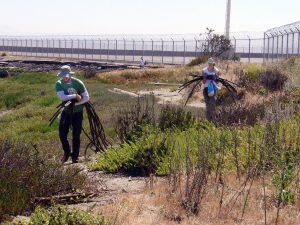Moving up(lands) at Pier 94
By Ilana DeBare
Golden Gate Bird Alliance’s habitat work at Pier 94 in San Francisco is entering an exciting new stage – restoration of the uplands area.
Are you familiar with Pier 94? Most San Franciscans aren’t; they don’t have a reason to stop at this small 5.5-acre natural oasis on the city’s southern waterfront, sandwiched between a stone, sand and gravel processing facility and other industrial port properties.
But many GGBA members know Pier 94 well – from volunteering on the restoration work there, or stopping by to look for shorebirds and Osprey, or viewing the amazing kite photos we shared on this blog last summer.
Before 1960, Pier 94 was a salt marsh with a variety of wetland plants that likely included California sea-blite or Suaeda Californica. But over the next several decades, the marsh deteriorated into an informal dumping site for asphalt and concrete, old tires, rebar and other materials.

In the wake of a disastrous 1996 oil spill in the Bay, the Port of San Francisco offered up Pier 94 as a site that could mitigate some of the spill damage. The Restoration Plan resulting from the spill agreed that restoration of Pier 94 could provide benefits such as:
- Additional spawning and nursery habitat for fish.
- Foraging and roosting habitat for shorebirds, wading birds, waterfowl, passerines and raptors.
- Improved water quality by trapping sediments from runoff and filtering out contaminants.
- Environmental public use opportunities.
Golden Gate Bird Alliance played the lead role in advocating for restoration of Pier 94, and entered into a long-term partnership with the Port, which owns the site. Starting in 2002, GGBA has coordinated monthly volunteer work days that include planting and monitoring California sea-blite, removing trash and non-native plants, and inventorying plants and wildlife at the site.
Until recently, nearly all of the work focused on the shoreline or marsh section of the site. Today that area is a healthy marsh that is home to a variety of marine life and birds such as American Avocets, Long-billed Curlews and Black Oystercatchers.
Which brings us to the next stage … the uplands. We’re now working on similar restoration of the uplands area of the site. Together with the Port, we tested the soil in that area in 2011 and found that it was filled with rebar, concrete and other rubble that would not support native vegetation. On the advice of consulting ecologists, we developed a plan to place a level of native plant-friendly sediment over the rubble — the kind of sediment that would have been in place before Pier 94 was a landfill.
We received generous donations of more than 3,000 cubic yards of sediment from three local sources — Hansen Aggregate, Pier 94’s immediate neighbor; Barnard Impregilo Healy J.V., contractor for the Central Subway Project in San Francisco; and Lawson Construction Services and S and S Trucking, contractors for the Transbay Terminal project.
![BIH Central Subway material_0423[3]](https://goldengatebirdalliance.org/wp-content/uploads/BIH-Central-Subway-material_04233-300x225.jpg)
On June 5th, trucks deposited the final load of sediment at Pier 94. Now we’ve hired a nearby company, Yerba Buena Engineering, to grade the material so it is leveled out into a natural configuration. Because we can’t start planting until the next rainy season, they’ll apply a biologically-friendly sealant to hold the soil in place and prevent weeds from sprouting.

![130321Pier94_0853[5]](https://goldengatebirdalliance.org/wp-content/uploads/130321Pier94_08535-300x225.jpg)
We’ll monitor the progress of the uplands area for three years, documenting what grows and what wildlife arrives. Some likely bird visitors to the uplands could be Western Meadowlarks, Red-winged Blackbirds, and White-crowned Sparrows.
The total cost of the uplands restoration project will be $132,000, of which $75,000 has been funded by a Prop 84 Urban Greening grant from the State of California Natural Resource Agency.
Clearly we still need to raise some money! If you know of foundations, companies or others who might want to support this project, let us know.
![6-1-2013 Pier 94 005 copy[9]](https://goldengatebirdalliance.org/wp-content/uploads/6-1-2013-Pier-94-005-copy9-225x300.jpg)
Directions are on the volunteer page of our web site, or click on this map. Come join us!

